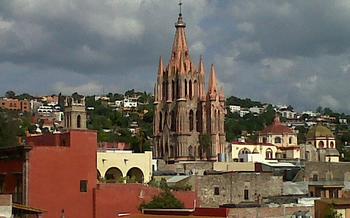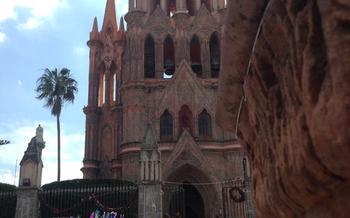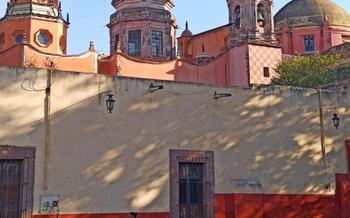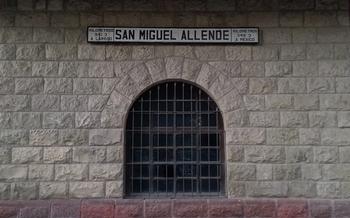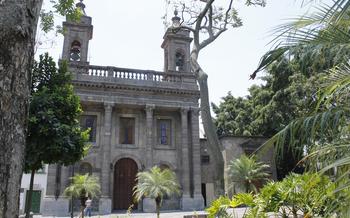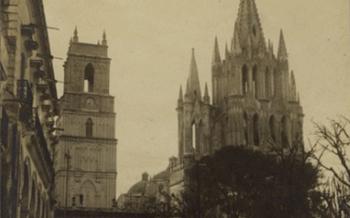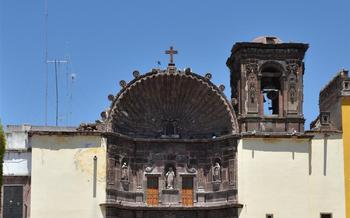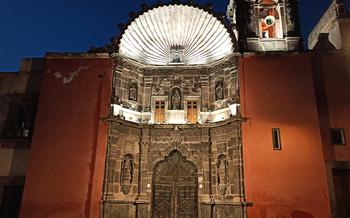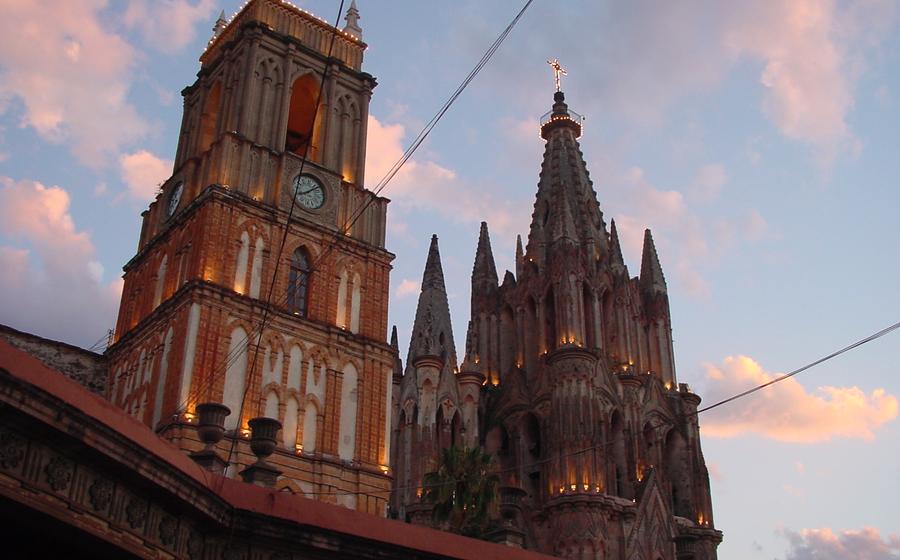
Parroquia de San Rafael
- A Baroque Masterpiece in the Heart of Mexico
- The Genius of Zeferino Gutierrez
- A Symphony in Stone
- Stepping into the Divine
- A Journey Through Time
- The Legend of the Flying Buttresses
- A Beacon of Faith
- A Cultural Tapestry
- A Place of Serenity and Reflection
- A Must-See for Architecture Enthusiasts
- A Photographic Gem
- A Journey Back in Time
- A Symbol of Resilience
- A Place of Cultural Exchange
- Insider Tip:
A Baroque Masterpiece in the Heart of Mexico
In the vibrant city of San Miguel de Allende, a jewel of Mexican Baroque architecture awaits discovery: the Parroquia de San Rafael. This iconic church, with its towering spires and intricate facade, stands as a testament to the genius of Zeferino Gutierrez, a visionary architect who left an indelible mark on Mexican religious architecture.
Situated in the heart of the city's historic center, the Parroquia is surrounded by charming cobblestone streets, art galleries, and boutique shops, beckoning visitors to immerse themselves in the rich cultural heritage of San Miguel de Allende. The church's unique architectural style, a harmonious blend of European and indigenous influences, sets it apart from any other in Mexico. While most Baroque churches in the country showcase a Churrigueresque style, characterized by ornate and intricate carvings, the Parroquia embraces a more restrained and elegant Neoclassical aesthetic, reflecting Gutierrez's innovative vision.
One intriguing fact about the Parroquia is that it was never actually finished according to Gutierrez's original plans. The construction, which began in 1880, was plagued by financial constraints and political turmoil, leading to the abandonment of several ambitious elements, including the completion of the two towers that were intended to flank the facade. Nevertheless, the unfinished state of the church adds to its charm and mystique, making it a truly unique architectural wonder.
The Genius of Zeferino Gutierrez
Zeferino Gutierrez, the visionary architect behind the Parroquia de San Rafael, was born in 1716 in the town of Ciénega de Mata, near Guadalajara. From a young age, he displayed a prodigious talent for architecture and design. His early works showcased his mastery of Baroque and Rococo styles, blending European influences with indigenous motifs.
In 1755, Gutierrez was commissioned to design and build the Parroquia de San Rafael in San Miguel de Allende. He approached this project with unwavering dedication and meticulous attention to detail. Gutierrez's artistic vision for the church was ambitious: to create a masterpiece that would fuse the best of European Baroque with the rich cultural heritage of Mexico.
Gutierrez's innovative use of materials and construction techniques set him apart from his contemporaries. He employed a unique combination of pink sandstone and volcanic rock, creating a striking contrast with the surrounding buildings. His mastery of vaults and arches allowed him to achieve remarkable structural feats, such as the soaring dome that crowns the church.
Anecdote:
Legends abound concerning Gutierrez's relentless pursuit of architectural perfection. One enduring tale speaks of a pact he made with the devil to ensure the timely completion of the Parroquia. It is said that the devil agreed to assist Gutierrez, on the condition that his likeness would be carved into the facade of the church. True to his word, Gutierrez depicted the devil's face amidst the intricate carvings adorning the facade, a testament to his audacious spirit and unwavering dedication to his craft.
A Symphony in Stone
The facade of the Parroquia de San Rafael is an intricate masterpiece of Baroque architecture, a testament to the genius of Zeferino Gutierrez. The church's facade is adorned with a multitude of sculptures and reliefs, each telling a unique story from the Bible. The central figure is that of the Archangel Michael, triumphantly slaying the dragon. Other sculptures depict scenes from the life of Jesus, the Virgin Mary, and various saints.
The facade also showcases a fusion of indigenous and European artistic influences. The use of intricate geometric patterns and symbols is reminiscent of pre-Columbian art, while the overall design and structure of the facade are distinctly European. This fusion of cultures is a reflection of Mexico's rich history and heritage, where indigenous and European traditions have intertwined to create a unique and vibrant culture.
The imagery on the facade is not merely decorative; it carries deep historical and cultural significance. The scenes depicted in the sculptures and reliefs serve as a visual representation of the Catholic faith and its teachings. They were intended to educate and inspire the faithful, reminding them of the stories of the Bible and the lives of the saints.
Stepping into the Divine
Beyond the intricate facade of the Parroquia de San Rafael lies an interior that evokes a sense of awe and spirituality. The grand altar, with its opulent gold leaf and intricate carvings, takes center stage, drawing the eye upward toward the majestic vaulted ceiling. The altarpieces, adorned with sculptures of saints and angels, narrate biblical stories and add to the sacred atmosphere of the church.
The colorful stained-glass windows, a symphony of light and color, depict scenes from the Bible and the lives of saints. These windows, with their vibrant hues and intricate designs, bathe the interior in a warm, ethereal glow, creating a truly divine ambiance.
Among the many treasures within the Parroquia, one that holds a special place in the hearts of the faithful is the statue of the Virgin Mary, known as the "Weeping Virgin." Legend has it that during a particularly dry spell, the statue shed tears, a miraculous event that was interpreted as a sign of divine intervention. The Weeping Virgin is revered by the local community and attracts pilgrims from far and wide, who come to pray and seek her blessings.
A Journey Through Time
Throughout its existence, the Parroquia de San Rafael has witnessed countless historical events and is deeply intertwined with the fabric of San Miguel de Allende's history. It has served as a sanctuary during times of turmoil, a gathering place for religious celebrations, and a symbol of resilience in the face of adversity.
The church has played a pivotal role in the community's religious traditions. Each year, during the feast of San Miguel Arcángel, the city's patron saint, the Parroquia becomes the focal point of elaborate festivities that draw thousands of pilgrims from across the country. The church is adorned with colorful decorations, and processions fill the streets with music, dance, and vibrant costumes.
Despite its grand stature, the Parroquia has remained resilient through the passage of time. It has withstood earthquakes, fires, and other natural disasters, each time emerging as a symbol of the community's unwavering faith. The most notable incident occurred in 1922 when a massive earthquake struck the region, causing significant damage to the church's facade. However, through the tireless efforts of the community, the Parroquia was meticulously restored to its former glory, showcasing the deep bond between the people of San Miguel de Allende and their beloved church.
Anecdote:
One of the most intriguing stories surrounding the Parroquia de San Rafael is the tale of the hidden treasure buried beneath the church. Legend has it that during the Mexican Revolution, a group of rebels sought refuge in the church with a substantial amount of gold and silver. To protect the treasure from falling into the hands of the enemy, they buried it in a secret location within the church grounds. Despite numerous attempts to locate the treasure, it remains hidden to this day, fueling the imaginations of locals and visitors alike.
The Legend of the Flying Buttresses
One of the defining features of the Parroquia de San Rafael is its set of magnificent flying buttresses. These architectural marvels not only serve a practical purpose in supporting the church's structure but also hold a special place in local lore.
According to legend, the construction of these buttresses was a testament to the ingenuity and devotion of the local community. When the church was nearing completion, it was discovered that the original design lacked the necessary support to withstand the seismic activity common in the region. Undeterred, the townspeople came together to brainstorm a solution.
Inspired by divine intervention, a local mason named Juan had a vision of constructing flying buttresses to reinforce the structure. Despite skepticism from some, Juan remained steadfast in his belief, and with the help of his fellow townspeople, they embarked on this ambitious project.
As the buttresses rose higher, the townspeople's faith grew stronger. They worked tirelessly, pouring their hearts and souls into the construction, determined to protect their beloved church. Finally, after months of grueling labor, the buttresses were completed, ensuring the stability of the Parroquia for generations to come.
To this day, the flying buttresses of the Parroquia stand as a testament to the power of faith, community, and architectural ingenuity. They are a beloved symbol of San Miguel de Allende, drawing visitors from far and wide to marvel at their beauty and the enduring legend that surrounds them.
A Beacon of Faith
The Parroquia de San Rafael is not just an architectural marvel; it is also a beacon of faith for the people of San Miguel de Allende. The church is dedicated to San Rafael, the patron saint of travelers and pilgrims, and it has been a place of worship and devotion for centuries.
The Parroquia is a popular destination for pilgrims from all over Mexico and beyond. They come to pray to San Rafael, to ask for his protection and guidance on their journeys, and to seek his healing power. The church is also a popular venue for weddings, baptisms, and other religious ceremonies.
The annual festivities in honor of San Rafael are a highlight of the year in San Miguel de Allende. The festivities include a procession through the streets, music, dancing, and food. The church is decorated with colorful streamers and flowers, and the atmosphere is one of joy and celebration.
Anecdote: A Personal Story of Faith and Answered Prayers at the Parroquia
I have a personal story of faith and answered prayers at the Parroquia de San Rafael. A few years ago, I was going through a difficult time in my life. I was feeling lost and alone, and I didn't know where to turn. One day, I decided to visit the Parroquia. I sat in the pews and prayed to San Rafael for guidance and strength.
As I prayed, I felt a sense of peace and calm wash over me. I knew that I was not alone, and that San Rafael was with me. I left the church feeling renewed and hopeful.
A few weeks later, I received a job offer that was perfect for me. I knew that it was San Rafael who had answered my prayers. I am so grateful for the Parroquia and for the faith and hope that it has given me.
A Cultural Tapestry
The Parroquia de San Rafael stands as a proud symbol of Mexican cultural heritage, deeply woven into the fabric of San Miguel de Allende's identity. It has become a platform for showcasing local arts and crafts, fostering a thriving creative community within the city.
The church's stunning architecture and intricate details have served as inspiration for countless Mexican artists, writers, and musicians. Its unique blend of Baroque and indigenous elements has found its way into paintings, sculptures, literature, and musical compositions, creating a rich tapestry of artistic expression.
One such artist, a local painter named Maria, found her muse in the Parroquia's majestic facade. Captivated by the interplay of light and shadow on the church's intricate carvings, she created a series of vibrant paintings that captured the essence of its beauty. Her work has since gained recognition and acclaim, attracting art enthusiasts from around the world.
The Parroquia's cultural influence extends beyond the visual arts. It has also played a significant role in promoting traditional Mexican music and dance. The church's spacious interior and excellent acoustics make it an ideal venue for concerts and performances, showcasing the talents of local musicians and dancers.
During the annual Fiestas de San Miguel, the Parroquia becomes the heart of the city's cultural celebrations. The church's plaza transforms into a vibrant stage, hosting traditional dance performances, folkloric music concerts, and colorful processions that pay homage to the city's patron saint.
Through its role in promoting local arts and crafts, the Parroquia de San Rafael has become a vibrant hub of cultural exchange, showcasing the rich heritage and traditions of San Miguel de Allende to visitors from around the world.
A Place of Serenity and Reflection
Amidst the vibrant energy of San Miguel de Allende, the Parroquia de San Rafael stands as an oasis of serenity and reflection. Its hallowed interior invites visitors to pause and connect with their spiritual side, offering a sanctuary for contemplation and growth. Here, amidst the intricate artwork and soft light filtering through stained-glass windows, one can find solace and a sense of peace.
Stepping into the Parroquia, a palpable sense of tranquility envelops you. The grand altar, with its ornate decorations and shimmering gold accents, draws the eye upward, inspiring awe and reverence. The colorful stained-glass windows, depicting scenes from the Bible, cast a warm glow upon the interior, creating an ethereal atmosphere that invites contemplation.
Throughout history, the Parroquia has served as a place of refuge and spiritual guidance for the people of San Miguel de Allende. Devotees come to pray, meditate, and seek solace in times of need. The church's peaceful ambiance fosters a sense of introspection and self-awareness, allowing visitors to connect with their inner selves and find harmony and balance.
Anecdote: During a particularly stressful period in my life, I sought solace within the walls of the Parroquia. As I knelt before the altar, a sense of calm washed over me. The soft light and serene atmosphere invited me to let go of my worries and connect with a higher power. In that moment of tranquility, I found the strength and clarity I needed to navigate through my challenges. The Parroquia became my sanctuary, a place where I could find peace and renewal amidst life's storms.
A Must-See for Architecture Enthusiasts
The Parroquia de San Rafael stands as a testament to the architectural prowess of Mexico. Its unique design and intricate details make it a prime example of Mexican Baroque architecture, a style that emerged during the 17th and 18th centuries. The Parroquia's distinct features set it apart from other churches in the region. Its twin towers, crowned with intricate spires, reach towards the sky, creating a majestic presence. The facade, adorned with elaborate carvings and sculptures, tells a visual story of faith and history.
The Parroquia's unique architectural style has had a significant influence on Mexican architecture, leaving a lasting legacy on the country's cultural heritage. Its innovative use of materials and construction techniques, such as the intricate flying buttresses, showcases the ingenuity and craftsmanship of the Mexican people.
For architecture enthusiasts, the Parroquia de San Rafael is a must-see destination. It offers a glimpse into the rich history of Mexican architecture and provides an opportunity to appreciate the artistic and cultural significance of this remarkable landmark.
Anecdote
I once had the privilege of meeting a renowned architect who was visiting the Parroquia for the first time. He was captivated by its beauty and spent hours studying its intricate details. He explained that the Parroquia was a masterpiece of Mexican Baroque architecture, showcasing a harmonious blend of European and indigenous influences. He left the church inspired, with a newfound appreciation for the architectural heritage of Mexico.
A Photographic Gem
The Parroquia de San Rafael is a photographer's paradise, attracting enthusiasts from around the world with its stunning visuals. Whether you're a professional or an amateur, capturing the essence of this architectural masterpiece is an experience like no other.
Tips for Capturing Stunning Shots:
-
Embrace the Golden Hour: The warm glow of the early morning or late afternoon sun casts a magical light on the Parroquia's facade, creating a surreal ambiance. Plan your visit accordingly to take advantage of this golden opportunity.
-
Explore Different Perspectives: Experiment with various angles to capture the church's grandeur. Whether you're shooting from the bustling plaza or seeking unique vantage points from nearby rooftops, each perspective tells a different story.
-
Focus on Details: Don't limit yourself to wide shots. Zoom in on intricate carvings, delicate sculptures, and decorative elements that adorn the facade. These details add depth and character to your photographs.
-
Capture the Interior's Splendor: Step inside the church to capture the awe-inspiring interior. The stained-glass windows, grand altar, and ornate decorations provide endless opportunities for stunning compositions.
-
Play with Shadows and Light: The interplay of light and shadow creates dramatic effects, especially during the late afternoon. Use these elements to your advantage to add depth and dimension to your shots.
Anecdote:
I once stumbled upon a group of photographers gathered at the base of the Parroquia, their cameras poised to capture a rare moment. As the sun dipped below the horizon, the church's facade was bathed in a warm golden glow, casting long shadows that accentuated its intricate details. The photographers worked in unison, capturing the magical transformation of the church in their lenses. It was a testament to the Parroquia's enduring allure, inspiring artists to immortalize its beauty through the art of photography.
A Journey Back in Time
Stepping into the Parroquia de San Rafael feels like embarking on a journey through the annals of Mexican history and culture. The church's interior is a treasure trove of historical artifacts and relics, each telling a unique story about Mexico's rich past.
Admire the intricately carved wooden pulpit, a testament to the skill and artistry of Mexican craftsmen. Gaze upon the ancient baptismal font, where countless generations of San Miguelenses have received the sacrament of baptism. Explore the side chapels, each dedicated to a different saint or devotion, offering a glimpse into the diverse religious traditions of Mexico.
Don't miss the sacristy, where vestments, chalices, and other sacred objects are carefully preserved. Here, you can learn about the history of the Catholic Church in Mexico and the role it has played in shaping the country's culture and society.
Through these historical treasures, the Parroquia de San Rafael invites you to delve into the fascinating tapestry of Mexican history and gain a deeper appreciation for the country's rich cultural heritage.
A Symbol of Resilience
The Parroquia de San Rafael has stood the test of time, showing remarkable resilience in the face of several earthquakes and other natural disasters. The church's solid construction and the dedication of the community have played a crucial role in its preservation. After each disaster, the people of San Miguel de Allende have come together to repair and restore the Parroquia, ensuring that it remains a symbol of their faith and cultural heritage.
One remarkable story of resilience is the church's survival of the devastating earthquake that struck Mexico in 198The earthquake caused widespread damage throughout the country, but the Parroquia emerged relatively unscathed. While some minor cracks appeared in the walls, the church's structure remained intact, a testament to the quality of its construction.
The people of San Miguel de Allende were determined to restore the Parroquia to its former glory. They worked tirelessly to repair the damage and reinforce the church's structure. Through their efforts, the Parroquia was fully restored and reopened within a few years. This remarkable feat demonstrated the community's deep affection for their beloved church and their commitment to preserving its legacy.
Today, the Parroquia de San Rafael stands as a symbol of resilience, a testament to the strength of the human spirit. It is a reminder that even in the face of adversity, hope and determination can prevail.
A Place of Cultural Exchange
The Parroquia de San Rafael is not just a religious site but also a vibrant hub for cultural exchange. Throughout the year, the church hosts a variety of events and exhibitions that celebrate Mexican culture and traditions. From classical music concerts to contemporary art shows, there's always something happening at the Parroquia.
One of the most popular events is the annual Festival de Música Sacra, which showcases sacred music from around the world. The festival features performances by renowned musicians and choirs, filling the church with beautiful melodies and harmonies.
Art enthusiasts can enjoy regular exhibitions showcasing the works of local and international artists. The Parroquia's grand interior provides a stunning backdrop for these exhibitions, allowing visitors to appreciate the artwork in a unique and inspiring setting.
The church also hosts workshops and classes on various aspects of Mexican culture, such as traditional dance, cooking, and artesanía (handicrafts). These workshops offer a hands-on opportunity to learn about Mexican traditions and create your own unique souvenirs.
Anecdote:
During my visit to the Parroquia, I had the privilege of attending a traditional Mexican music concert. The church was packed with locals and tourists alike, all eager to experience the vibrant sounds of Mexican folk music. The concert featured a talented group of musicians who played traditional instruments like the guitar, violin, and marimba. The music was infectious, and the crowd couldn't help but tap their feet and sway to the rhythm.
As the concert came to an end, I couldn't help but feel a sense of joy and connection to the Mexican culture. The Parroquia de San Rafael truly is a place where people from all walks of life can come together to celebrate the beauty and diversity of Mexican traditions.
Insider Tip:
To experience the true magic of the Parroquia de San Rafael, plan your visit for a weekday morning when the crowds are at a minimum. This will allow you to soak in the serene atmosphere, admire the intricate details of the facade, and capture stunning photographs without distractions. As the sun rises, the church's exterior glows with a warm golden hue, creating a picturesque backdrop for your shots.
After your visit to the Parroquia, enhance your cultural immersion by exploring the charming cafes and restaurants nestled around the Jardín Allende, the central square of San Miguel de Allende. Indulge in traditional Mexican cuisine, savor a cup of freshly brewed coffee, and soak up the vibrant atmosphere of this historic city.
One local's secret spot for a breathtaking view of the Parroquia is from the rooftop terrace of the Hotel Nena, located just a few steps away. As you sip on a refreshing margarita and gaze upon the iconic church, you'll feel like you've stepped into a living postcard, surrounded by the beauty and history of San Miguel de Allende.
